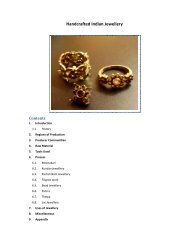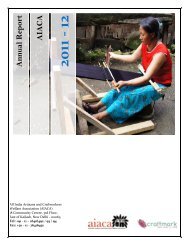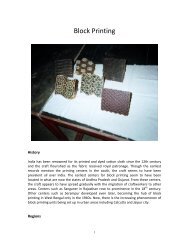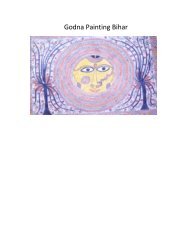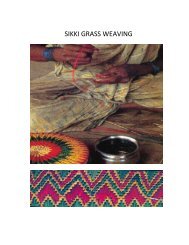Create successful ePaper yourself
Turn your PDF publications into a flip-book with our unique Google optimized e-Paper software.
fascinating piece of gold tissue on which are woven brightly colored rosettes and<br />
sometimes birds.<br />
Assam leads in non-mulberry silk. Sericulture is an ancient vocation practiced by a large<br />
number of cultivators in non-agricultural seasons.. Assam has several varieties of silks:<br />
eri, which derives its name from the castor leaves on which the worm feeds. This silk has<br />
a yellowish tinge, is in rough as well as smooth varieties, and is used in winter for its<br />
warmth.<br />
Sualkuchi is the most famous center in Assam for silk weaves of delicate texture, dainty<br />
designs and delightful natural colors. Its specialty is the Assamese women’s dress like<br />
the mekhela. This is a woman’s lungi, mostly with plain body, but sometimes having<br />
motifs strewn over the fabric, with a heavy design at the ends. The chaddar and riha are<br />
in smaller lengths: the former going over the shoulder to provide a pallu, the other<br />
wrapped round the waist, both decorative.<br />
Kashmir too lays equal claim to antiquity in silk industry. Kashmir was amongst the<br />
earliest to export silk to West and Central Asia. Over the last thirty years, there has been<br />
introduction of modern silk fabrics here like crepe de chine, georgette, chiffon, etc. This<br />
area has become an important center for silks.<br />
South India is famous for its heavy quality silks. At one time silk fabrics were sold here<br />
by the weight, so heavy were the weaves. Tamil Nadu and Karnataka are notable areas<br />
for this type of silk. A village of Karnataka called Mokalmoru has a richly designed sari<br />
with all over motifs, each enclosed in a check. The border is done in ikat weave. The<br />
pallu is daintily decorated with birds, fishes, etc.<br />
In Tamil Nadu the pride of place goes to Kanchipuram, though Kollegal in Coimbatore<br />
district and Kumbakonam in Tanjore district, Salem and Arni, also have very fine<br />
<strong>weaving</strong> with their own distinct motifs. Weaving is done in Kanchipuram by Salgars, a<br />
name derived from the Sanskrit salika for weaver. They claim descent from sage<br />
Markanda, the weaver of the gods. The throw-shuttle loom in which the shuttle is<br />
thrown by hand is used. For complicated designs a local type of jacquard is used,<br />
fashioned out of round lamp wicks as are used in room lamps, and plaited twins, and<br />
attached to the loom. Mechanical hooks and jacquard boxes are now being introduced.<br />
Kanchipuram has a special name for each of its many designs and colors. Very intricate<br />
designs are woven into the body in gold thread. These are of human and animal figures,<br />
geometrical patterns, with temple towers along the borders. A distinctive characteristic<br />
of the Kanchipuram sari is the wide contrast borders. For this three shuttles are needed





